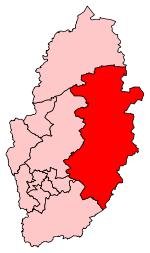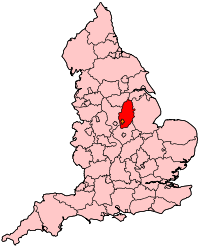Newark is a constituency[n 1] in Nottinghamshire, England. It is currently represented by Robert Jenrick of the Conservative Party, who won the seat in a by-election on 5 June 2014, following the resignation of Patrick Mercer in April 2014.[n 2]
Boundaries
1918–1950: The Municipal Borough of Newark, and the Rural Districts of Bingham, Newark, and Southwell.
1950–1983: The Municipal Borough of Newark, the Urban District of Mansfield Woodhouse, and the Rural Districts of Newark and Southwell.
1983–2010: The District of Newark wards of Beacon, Bridge, Bullpit Pinfold, Castle, Caunton, Collingham, Devon, Elston, Farndon, Magnus, Meering, Milton Lowfield, Muskham, Southwell East, Southwell West, Sutton on Trent, Trent, and Winthorpe, and the District of Bassetlaw wards of East Markham, East Retford East, East Retford North, East Retford West, Elkesley, Trent, and Tuxford.
2010–present: The District of Newark and Sherwood wards of Balderton North, Balderton West, Beacon, Bridge, Castle, Caunton, Collingham and Meering, Devon, Farndon, Lowdham, Magnus, Muskham, Southwell East, Southwell North, Southwell West, Sutton-on-Trent, Trent, and Winthorpe, the District of Bassetlaw wards of East Markham, Rampton, Tuxford, and Trent, and the Borough of Rushcliffe wards of Bingham East, Bingham West, Cranmer, Oak, and Thoroton.
The constituency covers large parts of the Newark and Sherwood district which encompasses the east of Nottinghamshire, as such includes the towns of Newark-on-Trent and Southwell, and the villages of Collingham and Sutton-on-Trent. It also covers parts of the Bassetlaw and Rushcliffe areas including Markham Moor and Bingham.
History
A parliamentary borough of the same name existed from 1673 to 1885, when it was replaced by a county division of the same name, the year of the Redistribution of Seats Act 1885.
Newark was the last borough to be added to the Unreformed House of Commons which took place in 1673, prior to the Reform Act 1832. It returned two representatives to Parliament from 1673 until 1885. The future Prime Minister, William Ewart Gladstone, began his political career as Member of Parliament for Newark from 1832 to 1845.
More recently, the Labour Party held Newark (on substantially different boundaries to the present ones) from 1950 until 1979, when it was taken by the Conservatives' Richard Alexander. Alexander lost his seat during Labour's landslide victory at the 1997 general election. The victorious Labour candidate, Fiona Jones, was convicted of electoral fraud and expelled from the House of Commons in 1999 over misrepresented election expenses. The conviction was later overturned upon appeal and she returned to Parliament. However, Jones lost her seat at the 2001 general election to Patrick Mercer of the Conservatives, who held it until 2014.
Mercer held the position of Shadow Minister for Homeland Security from June 2003 until March 2007, when he was forced to resign following racially contentious comments made to The Times.[2]
The Newark constituency in 2010 lost the town of Retford to the Bassetlaw constituency (although Newark still has a smaller part of the Bassetlaw district), but gained land in and around Bingham from the Rushcliffe constituency.
Following an investigation by Commons authorities finding that Mr Mercer had engaged in paid lobbying, not properly reported the income or declared his interest, and repeatedly seriously denigrated other members, Patrick Mercer stepped down as MP for Newark on 30 April 2014.[3]
Robert Jenrick was elected in the subsequent by-election, in the Conservative Party's largest by-election majority for four decades. He is Parliamentary Private Secretary to the Justice Secretary and Lord Chancellor, Michael Gove.
Constituency profile
Many towns are historic in architecture[4] with many well-preserved listed buildings[5] whereas much of the council housing in the constituency has been privately acquired and improved under the right to buy.[6] Nonetheless there is a significant minority of social housing but this dependency and the proportion of flats is lower than the national average across the three districts.[7]
Labour held the seat for one term following their 1997 landslide victory, but subsequent major boundary changes have brought in more rural areas and made the seat into one of the most strongly Conservative voting in the UK.
Members of Parliament
MPs before 1885
MPs since 1885
Elections
Elections in the 2010s
Elections in the 2000s
Elections in the 1990s
Elections in the 1980s
Elections in the 1970s
Elections in the 1960s
Elections in the 1950s
Elections in the 1940s
Elections in the 1930s
Elections in the 1920s
Elections in the 1910s
- endorsed by the Coalition Government.
Elections in the 1900s
Elections in the 1890s
Viscount Newark was re-elected unopposed in 1892, but stood down in the 1895 general election when a Conservative candidate Harold Heneage Finch-Hatton was elected unopposed. Finch-Hatton resigned in 1898, and Viscount Newark was returned unopposed at the resulting by-election.[29]
Elections in the 1880s
Viscount Newark was re-elected unopposed in 1886.[29]
See also
Notes and references
- Notes
- ↑ A county constituency (for the purposes of election expenses and type of returning officer)
- ↑ As with all constituencies, the constituency elects one Member of Parliament (MP) by the first past the post system of election at least every five years.
- References
- ↑ "Electorate Figures – Boundary Commission for England". 2011 Electorate Figures. Boundary Commission for England. 4 March 2011. Retrieved 13 March 2011.
- ↑ Byers, David (8 March 2007). "Exclusive Tory frontbencher sparks race row with black bastards gibe". The Times. London.
- ↑ "Former Tory MP Mercer resigns after Commons suspension". BBC. Retrieved 29 April 2014.
- ↑ "Newark Conservative: Patrick Mercer". The Guardian. London.
- ↑ Ordnance Survey map, courtesy of English Heritage
- ↑ 2001 Census
- ↑ 2011 census interactive maps
- 1 2 3 Leigh Rayment's Historical List of MPs – Constituencies beginning with "N" (part 1)
- ↑ Craig, F. W. S. (1989) [1977]. British parliamentary election results 1832–1885 (2nd ed.). Chichester: Parliamentary Research Services. pp. 215–6. ISBN 0-900178-26-4.
- ↑ Stooks Smith, Henry. (1973) [1844–1850]. Craig, F. W. S., ed. The Parliaments of England (2nd ed.). Chichester: Parliamentary Research Services. pp. 249–250. ISBN 0-900178-13-2.
- ↑ "Election Data 2015". Electoral Calculus. Archived from the original on 17 October 2015. Retrieved 17 October 2015.
- ↑ "Newark by-election candidate names confirmed". BBC News. 13 May 2014.
- ↑ Returning officer's declaration, BBC television, 6 June 2014
- ↑ "Election Data 2010". Electoral Calculus. Archived from the original on 26 July 2013. Retrieved 17 October 2015.
- ↑ "Election Data 2005". Electoral Calculus. Archived from the original on 15 October 2011. Retrieved 18 October 2015.
- ↑ "Election Data 2001". Electoral Calculus. Archived from the original on 15 October 2011. Retrieved 18 October 2015.
- ↑ "Election Data 1997". Electoral Calculus. Archived from the original on 15 October 2011. Retrieved 18 October 2015.
- ↑ "Election Data 1992". Electoral Calculus. Archived from the original on 15 October 2011. Retrieved 18 October 2015.
- ↑ "Politics Resources". Election 1992. Politics Resources. 9 April 1992. Retrieved 6 December 2010.
- ↑ "Election Data 1987". Electoral Calculus. Archived from the original on 15 October 2011. Retrieved 18 October 2015.
- ↑ "Election Data 1983". Electoral Calculus. Archived from the original on 15 October 2011. Retrieved 18 October 2015.
- ↑ British Parliamentary Election Results 1918–1949, FWS Craig
- ↑ British Parliamentary Election Results 1918–1949, FWS Craig
- ↑ British Parliamentary Election Results 1918–1949, FWS Craig
- ↑ British Parliamentary Election Results 1918–1949, FWS Craig
- ↑ British Parliamentary Election Results 1918–1949, FWS Craig
- ↑ British Parliamentary Election Results 1918–1949, FWS Craig
- ↑ British Parliamentary Election Results 1918–1949, FWS Craig
- 1 2 3 4 "Election intelligence". The Times (36069). London. 19 February 1900. p. 13.
Coordinates: 53°06′N 0°54′W / 53.10°N 0.90°W / 53.10; -0.90

